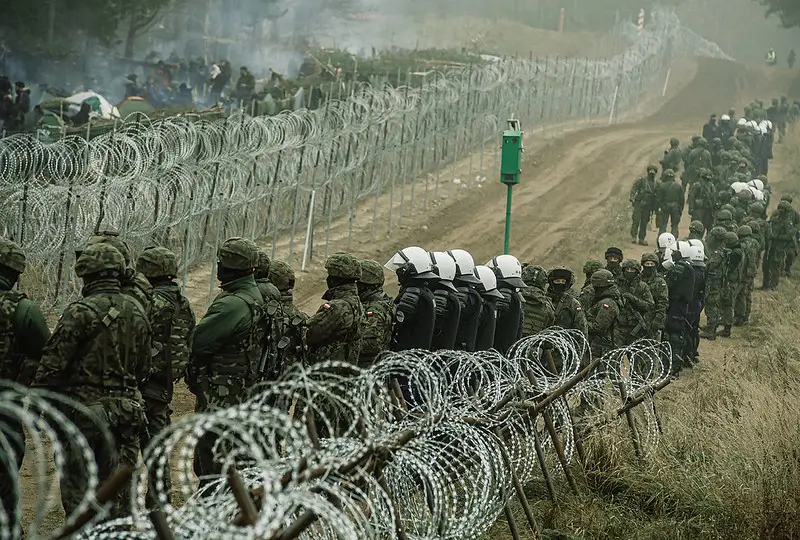
The Polish problem: On the frontline of migration
More and more refugees are arriving in Europe via the northeastern route—through war-torn Russia and Belarus, whose airspaces are officially closed. As a result of this shift, Poland has become the main buffer state, trying to halt a migration flow that Moscow is deliberately fueling for political purposes: the destabilization of Europe.
According to data from Frontex, the EU border agency, migration traffic on the Balkan route fell by 56% in the first five months of 2025, while on the northeastern route, from Russia and Belarus, there was only an 7% decrease. The northeastern route, whose traffic is now comparable in magnitude to that of the Balkan route, has clearly become one of Europe's main entry points, and Poland has become the primary frontline state for European migration.
State-sponsored air piracy
To understand how this came about, one must look back to May 23, 2021, when Belarusian authorities forcibly diverted a Ryanair flight traveling from Athens to Vilnius. As the plane crossed Belarusian airspace, Minsk air traffic control ordered it to land, citing a false bomb threat. The Belarusian air force even scrambled a MiG–29 fighter jet to force compliance. Onboard was Roman Protasevich, a Belarusian opposition journalist persecuted by the Lukashenko regime, who was immediately arrested after landing. The international community condemned the act as state air piracy and a grave violation of international law. In response, the European Union imposed sanctions on Belarus, including its national airline Belavia and state leadership—unwittingly setting in motion the political spiral that later saw Minsk weaponize migration against the EU.
For Polish politics and society, migration pressure from Belarus and Russia is not seen as a humanitarian or refugee crisis but as a security threat. Both the Polish government and most of the public agree that much of the movement along the northern route is artificially organized—not to seek asylum, but to destabilize the EU. Warsaw views Belarus and Russia as using migration as a hybrid warfare tool, designed to sow division within the EU and exploit internal disagreements over refugee policy.
Consequently, Poland treats border protection as a security—not humanitarian—matter. Both the previous Law and Justice (PiS) government and the current centrist coalition led by Donald Tusk hold essentially the same position: defending the eastern border is both a matter of national sovereignty and European security. The main difference lies in tone: PiS framed the border wall as a defense of Christian Europe and national independence, while Tusk presents it as a European security effort requiring transparency and cooperation. Both, however, have maintained the physical barrier, the military presence, and the practice of pushbacks.
A border fence won't solve everything
By 2022, Poland had completed a 186-kilometer steel fence along the Belarusian border, equipped with thermal cameras and motion sensors, at a cost of 1.6 billion złoty (about €370 million). Thousands of border guards and soldiers patrol the area, where, in some periods of 2024, authorities recorded 200–300 illegal crossing attempts per day. Maintaining this infrastructure adds another €100–150 million annually, while the continuous military presence—estimated at 6,000–8,000 troops on rotation—further strains the budget. In 2024, Warsaw launched a new “Shield-East” defense program worth 10 billion złoty (€2.3 billion) to strengthen the eastern frontier against hybrid threats.
The humanitarian burden is also significant. Although the state enforces strict border control, local villages, hospitals, and NGOs frequently aid exhausted or injured migrants. Between 2023 and 2024, over 3,000 cases of medical assistance were recorded. The Polish Red Cross, Caritas, and other groups have mobilized millions of złoty in aid, though their access to the border zone remains restricted. Human rights groups such as Grupa Granica and Amnesty Polska have criticized authorities for conducting pushbacks, blocking asylum claims, and concealing deaths along the border.
Civil organizations are not opposing border protection per se—they demand that it be carried out more humanely and transparently. Both the ombudsman and humanitarian groups argue that upholding security must go hand in hand with protecting life and respecting asylum rights. The Tusk government has promised better dialogue with NGOs, though it has not softened border policy.
Divided Public Opinion
Polish society remains deeply divided. According to 2024 CBOS data, 73% of Poles support maintaining the border fence, and 68% believe that migration is being used as a political weapon by Russia and Belarus. At the same time, a slim majority—54%—say that basic humanitarian aid should still be provided to those in distress. The Polish public, in other words, is security-minded but not hostile toward individuals.
The handling of the eastern migration crisis is one of the few issues where Warsaw and Brussels largely see eye to eye. While Poland and the EU have clashed in the past—over rule of law, refugee quotas, and judicial reforms—both now interpret migration from Belarus and Russia as a coordinated, state-backed destabilization attempt. The European Commission and Frontex recognize Poland as a frontline state and provide financial support for border defense.
The financial toll, however, is enormous. Border infrastructure, defense operations, and humanitarian assistance together cost an estimated €1.5–2 billion annually. While not crippling for Poland’s GDP, the burden weighs heavily on the eastern provinces, local infrastructure, and healthcare systems. The flow of migrants from Belarus remains steady, while provocations—such as drone flights, laser attacks, and Belarusian soldiers escorting migrants to the fence—have become routine.
In Polish public discourse, resisting eastern migration pressure has become synonymous with defending national sovereignty and security. Across the political spectrum, there is consensus that the border must be protected—but many stress that security and human dignity need not be mutually exclusive. The real question, then, is not whether to defend the border, but how to do so within the bounds of democratic values and humanity.
SIDEBAR: How can migrants come from “closed” airspaces?
Most migrants arriving via the northeastern route are not Russians or Ukrainians but come from the Middle East and Africa—Syria, Iraq, Afghanistan, Yemen, Congo, Somalia. They enter Russia or Belarus legally, often on tourist or student visas, arranged through local travel agencies offering “fake tourism” packages (such as “Minsk city tours” including flights and hotel stays). Although direct flights between the EU and Russia have stopped, both Russia and Belarus still receive flights from Turkey (Istanbul), Egypt (Cairo), the UAE (Dubai), Lebanon, Iran, and India. Migrants often fly via Istanbul to Minsk or Moscow, from where they are transported—sometimes escorted—to the EU border. According to European security agencies, Belarusian and Russian border guards frequently assist these groups in reaching EU territory. The goal is not to help genuine refugees but to exert political pressure on the EU—much like the 2021 Lukashenko crisis. The EU now refers to this phenomenon as “weaponized migration.”





